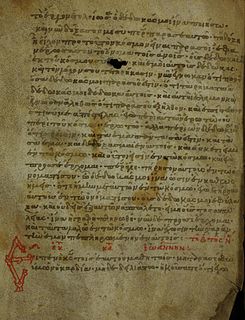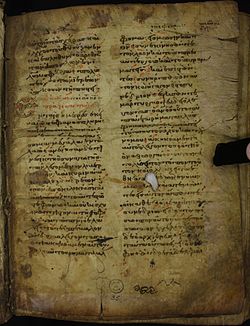Description
The codex contains lessons from the Acts and Epistles lectionary (Apostolarion), on 160 parchment leaves (26.4 cm by 19.7 cm), with lacunae at the beginning and end. [3] The text is written in Greek minuscule letters, in two columns per page, 28-29 lines per page. [1] It is ill written. [4] It contains musical notes in red. [2]

Acts of the Apostles, often referred to simply as Acts, or formally the Book of Acts, is the fifth book of the New Testament; it tells of the founding of the Christian church and the spread of its message to the Roman Empire.

A lectionary is a book or listing that contains a collection of scripture readings appointed for Christian or Judaic worship on a given day or occasion. There are sub-types such as a "gospel lectionary" or evangeliary, and an epistolary with the readings from the New Testament Epistles.

A lacuna is a gap in a manuscript, inscription, text, painting, or a musical work. A manuscript, text, or section suffering from gaps is said to be "lacunose" or "lacunulose". Some books intentionally add lacunas to be filled in by the owner, often as a game or to encourage children to create their own stories.
The text reaches from the second Sunday after Easter, through the Ascension, Pentecost, to the sixteenth week after Pentecost. The Menology (folios 114 v – 160) has almost no lessons given at length, but overflows with rubrical directions. [4]

Easter, also called Pascha or Resurrection Sunday, is a festival and holiday commemorating the resurrection of Jesus from the dead, described in the New Testament as having occurred on the third day after his burial following his crucifixion by the Romans at Calvary c. 30 AD. It is the culmination of the Passion of Jesus, preceded by Lent, a 40-day period of fasting, prayer, and penance.

The Christian holy day of Pentecost, which is celebrated on the seventh Sunday after Easter, commemorates the descent of the Holy Spirit upon the Apostles and other followers of Jesus Christ while they were in Jerusalem celebrating the Feast of Weeks, as described in the Acts of the Apostles. In Christian tradition, this event represents the birth of the early Church.

Minuscule 535, 548 (Scrivener), ε 140, is a Greek minuscule manuscript of the New Testament, on a parchment, dated to the 12th century. It was adapted for liturgical use, with full marginalia.
Minuscule 540, ε 334, is a Greek minuscule manuscript of the New Testament, on a parchment. Palaeographically it has been assigned to the 14th century.
Scrivener labelled it by number 553.
It has marginalia. The manuscript has no complex context.
Minuscule 542, ε 336, is a Greek minuscule manuscript of the New Testament, on a parchment. Palaeographically it has been assigned to the 13th century.
Scrivener labelled it by number 555.
The manuscript is lacunose. Currently it is inaccessible.

Minuscule 544, 557, ε 337, is a Greek minuscule manuscript of the New Testament, on parchment. The manuscript has complex contents. Palaeographically it has been assigned to the 13th century.
It was not adapted for liturgical use.

Minuscule 546, ε 511, is a Greek minuscule manuscript of the New Testament, on parchment. It is dated palaeographically to the 13th century. It has some marginalia, the scribe has made numerous errors.
Lectionary 186, designated by siglum ℓ 186 is a Greek manuscript of the New Testament, on parchment leaves. Palaeographically it has been assigned to the 11th century.
Scrivener labelled it by 221e.
Lectionary 214, designated by siglum ℓ 214, is a Greek manuscript of the New Testament, on parchment. Palaeographically it has been assigned to the 12th century.
Scrivener labelled it by 239evl.
Lectionary 215, designated by siglum ℓ 215 is a Greek manuscript of the New Testament, on parchment. Palaeographically it has been assigned to the 13th or 14th century.
Scrivener labelled it by 240evl.

Lectionary 216, designated by siglum ℓ 216 is a Greek manuscript of the New Testament, on parchment. Palaeographically it has been assigned to the 13th century.
Scrivener labelled it by 251evl and 64apost.
Lectionary 217, designated by siglum ℓ 217 is a Greek manuscript of the New Testament, on parchment. Palaeographically it has been assigned to the 13th century.
Scrivener labelled it by 241evl.
Lectionary 218, designated by siglum ℓ 218 is a Greek manuscript of the New Testament, on paper. Palaeographically it has been assigned to the 15th century.
Scrivener labelled it by 242evl.
Lectionary 219, designated by siglum ℓ 219 is a Greek manuscript of the New Testament, on parchment. Palaeographically it has been assigned to the 11th century.
Frederick Henry Ambrose Scrivener labelled it by 243evl.

Lectionary 220, designated by siglum ℓ 220 is a Greek manuscript of the New Testament, on parchment. Palaeographically it has been assigned to the 13th century.
Frederick Henry Ambrose Scrivener labelled it by 244evl.
The manuscript is lacunose.

Lectionary 223, designated by siglum ℓ 223 is a Greek manuscript of the New Testament, on paper. Palaeographically it has been assigned to the 15th century.
Frederick Henry Ambrose Scrivener labelled it by 252evl.
It contains much additional material, liturgical and secular.
Lectionary 224, designated by siglum ℓ 224 is a Greek manuscript of the New Testament, on parchment. Palaeographically it has been assigned to the 14th century.
Scrivener labelled it by 247evl. The manuscript has complex contents.
Lectionary 222, designated by siglum ℓ 222 is a Greek manuscript of the New Testament, on parchment. Palaeographically it has been assigned to the 13th century.
Scrivener labelled it by 246evl.

Lectionary 225, designated by siglum ℓ 225 is a Greek manuscript of the New Testament, on paper. Palaeographically it has been assigned to the 15th century.
Scrivener labelled it by 248evl.
The manuscript has complex contents.

Lectionary 227, designated by siglum ℓ 227 is a Greek manuscript of the New Testament, on parchment. Palaeographically it has been assigned to the 14th century.
Scrivener labelled it by 250evl.
Many leaves of the manuscript were lost, some leave have survived in a fragmentary condition.

Lectionary 228, designated by siglum ℓ 228 is a Greek manuscript of the New Testament, on paper. Palaeographically it has been assigned to the 15th century.
Frederick Henry Ambrose Scrivener labelled it by 253evl.
Some leaves of the manuscript were lost.
Lectionary 315 (Gregory-Aland), designated by siglum ℓ 315 is a Greek manuscript of the New Testament, on paper. Palaeographically it has been assigned to the 16th century. The manuscript has been lost.

















